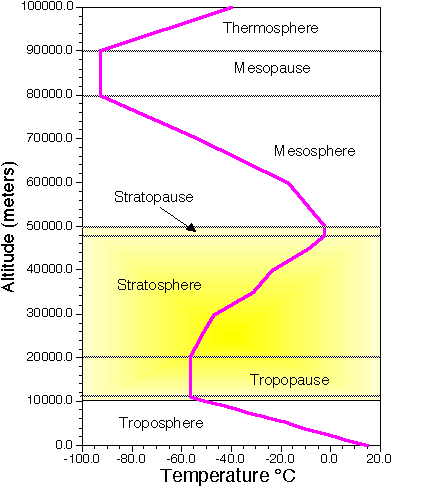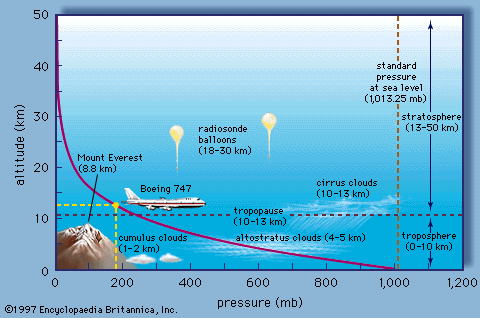The Atmosphere and the Weather
![[Home]](../../icons/home.jpg)
![[Lectures]](../../icons/lectures.jpg)
![[Previous]](../../icons/previous.jpg)
![[Next]](../../icons/next.jpg)
Vertical Structure of the Atmosphere
We will examine how air temperature, number density, and pressure change in the vertical, i.e.,
as one moves up and down in Earth's atmosphere. The average vertical structure of temperature, density,
and pressure in Earth's atmosphere described below is often called the "static structure" as
it does not consider large scale movements of air like wind currents. It is like describing how the
average properties of ocean water (e.g., water temperature and salinity) change in moving from the ocean
bottom to the top of the water without considering ocean currents.
Temperature
Often, the Earth's atmosphere is divided into several different layers that
are defined according to the typical change in air temperature. (See Image Below).
Layers of the atmosphere based on temperature
 |
| Atmospheric layers defined by structure of air temperature.
|
In this class, we will only cover the lowest three layers, the troposphere,
the tropopause, and the stratosphere: |
- Troposphere:
- Located from the surface of the Earth to approximately 11
kilometers in altitude. This is an average, as the depth of the troposphere
varies with time and location, range 6 - 16 km. Troposphere literally means
the "turning or changing sphere" in reference to the fact that this lowest
layer of the atmosphere is characterized by strong vertical mixing of air.
The upper boundary of the vertical mixing is at the top of the troposphere
at the troposphere-tropopause boundary.
- Essentially all weather and clouds occur in the troposphere or this
overturing layer.
- The troposphere contains about 75% of the total mass of the
atmosphere.
- Typically, the maximum air temperature occurs near the Earth's
surface and drops with increasing height at an average
rate of 6.5°C per 1000 meters (or 3.6°F per 1000 ft).
The reason the temperature usually
decreases with increasing height is because the atmosphere
is mainly heated from below by the underlying ground surface. The gas
molecules in the atmosphere are generally transparent for visible
radiation coming from the Sun, i.e., if it is not cloudy, most of
the Sun's radiation passes right through the atmosphere, and is absorbed
by the ground surface, heating the ground up. Air in contact with the
warm ground is heated from below, therefore, the air temperature typically
lowers as you move up away from the warm ground.
- However, it is not all that uncommon for there to be a shallow layer
of air where the air temperature actually increases with increasing
altitude. These layers are called temperature inversions and
can be very important in weather forecasting. One situation where
temperature inversions frequently form is just above the
ground surface during long winter nights caused by the air contacting
the cold ground surface. This type of inversion will persist into
the early morning until the sun
is able to heat the ground surface
(See Figure X).
- Figure X also indicates the typical changes in
air temperature that take place over the course of a day. The largest change in air temperature happens
just above the ground surface with much less change higher up. The reason is that the
ground surface temperature responds more rapidly to changes in radiation than the air.
During the day, the ground surface warms rapidly by absorbing radiation from the sun, which
heats the overlying air from the bottom up. At night, the ground surface cools rapidly by
emitting (or giving off) radiation energy, which cools the overlying air.
- Tropopause:
- Isothermal (constant temperature) layer that exists above the troposphere.
On average, it is found between about 11 and 20
kilometers. At these levels the air temperature is much colder than that
found near the ground surface.
- Separates the troposphere from the stratosphere.
- This change in vertical structure of air temperature (from cooling with increasing altitude
in the troposphere to remaining constant with increasing altitude in the tropopause), acts like a "lid" on rising air motion.
This "lid" can prevent air from moving vertically up or down through this troposphere-tropopause boundary. The
reason will be better explained in later lectures.
Because it is difficult for
tropospheric air to rise into the tropopause region, clouds are
typically confined below the tropopause region
(See Figure Y), since clouds form in air moving vertically upward.
This is why we say most clouds and weather are confined to the troposphere.
- Layer in the atmosphere where the jet stream
exists.
- Stratosphere:
- Extends from 20 to 48 kilometers above the
surface (average location).
- Temperature increases with altitude because ozone gas
molecules, present in this layer, absorb ultraviolet
sunlight creating heat energy.
- The layer of higher ozone concentrations, which reaches a maximum
between 20 and 30 km above sea level, is also called the ozone
layer. Ozone in the stratosphere
protects life from harmful exposure to the sun's
ultraviolet radiation. NOTE: Even though we refer to an "ozone layer",
keep in mind that ozone molecules account for a very small
percentage of all air molecules in the stratosphere. Even within the
ozone layer, ozone is still a trace constituent.
Density
Air density can be defined as the number of air molecules per
unit volume (number density). Near sea level there are about 2.7x1019
molecules per cm3(cubic centimeter) or 4.4x1020
molecules per inch3(cubic inch).
Air molecules are held near the earth by gravity. In other words,
air has weight. Weigh an empty bag, then fill it with
air, it now weighs more. In addition gases, like air, are easily compressed, i.e.,
squeeze a gas together and its number density increases. In other words, we
say gases are compressible because they can easily be squeezed into a smaller
volume. Solids and liquids on the other hand are not easily compressed.
The weight of all of the air above a given point in the atmosphere
squeezes air molecules closer together, which causes their numbers
in a given volume to increase (increase in number density).
The more air above a level (and hence the more weight of air above
a level), the greater the squeezing effect
(or compression).
Since air density is the number of air molecules in a
given space (volume), air density is typically greatest at the surface or sea level
(where it is squeezed by the weight of the entire atmosphere above) and
decreases as we move up in the atmosphere because the weight of
air above becomes less and hence there is less of a squeezing effect
(See Figure Z).
Pressure
Atmospheric air pressure results from the Earth's gravitational pull on the
overlying air. Without gravity holding the atmosphere just above the ground surface,
air molecules would spread out, and the gas pressure would be close to zero.
The weight of the atmosphere acts
as a force upon the underlying surface of the Earth. The amount of force excerted over an
area of surface is called atmospheric pressure or air
pressure. Near sea level, the average air pressure
is about 14.7 pounds per square inch. In this class we will use the
unit millibars(mb) to specify air pressure. At sea level the average
air pressure is 1013 mb. Another way to think of this is that the total weight
of all the air above sea levels weighs enough to cause 1013 mb of air pressure.
Since the air (a gas) is a fluid, the pressure
force acts in all directions, not just downward. The pressure
force pushing downward due to the weight of the air is the
same as the pressure force acting sideways and even upward.
If you are having trouble understanding this, make an
analogy with another fluid liquid water. Consider a deep swimming pool full
of water. The water pressure anywhere in the pool
depends on the weight of the water above (that is the deeper
you dive downward in the pool, the stronger the water pressure.)
The pressure force is not just downward though, it pushes in on your body
from all directions. The average air pressure at sea level (1013 mb or sometimes
called one atmosphere of pressure) is caused
by the weight of all the air above sea level. In the same way water pressure is
caused by the weight of water above you. At a depth of 32 feet (9.75 meters) below a water
surface, the water pressure is about one atmosphere. Thus, the entire column of air
from sea level to outer space weighs as much as a 32 foot column of water. Of course
diving deeper into water means you will encouter an increasing water pressure (enough
to crush you if you go too deep).
 |
| Typical change in air pressure with altitude. Note how rapidly air
pressure falls with increasing altitude.
|
In the atmosphere, the air pressure at any point caused by the
weight per area of the air above that point.
As we climb in elevation, fewer air molecules are above us (less weight of air above us);
hence, atmospheric pressure always decreases as you move upward
in the atmosphere
(See Figure B). Another way to look at it is that the air
pressure at any point in the atmosphere is exactly enough to support the
weight of the column of air above it. A balance exists between the
gravitational force pushing air downward and the upward directed pressure force. This
balance is called hydrostatic balance (see
figure).
Earlier we made an analogy between diving down in water and moving downward in the atmosphere.
In both cases, the fluid presure increases as you move down because there is more and more weight
of fluid above you. A big difference between water and air, though, is that air is compressible
and water is not. This affects the rate of pressure changes as one moves up or down in the fluid
as shown in Figure C, which compares the rate of vertical pressure changes
between water and air.
![[Home]](../../icons/home.jpg)
![[Lectures]](../../icons/lectures.jpg)
![[Previous]](../../icons/previous.jpg)
![[Next]](../../icons/next.jpg)

